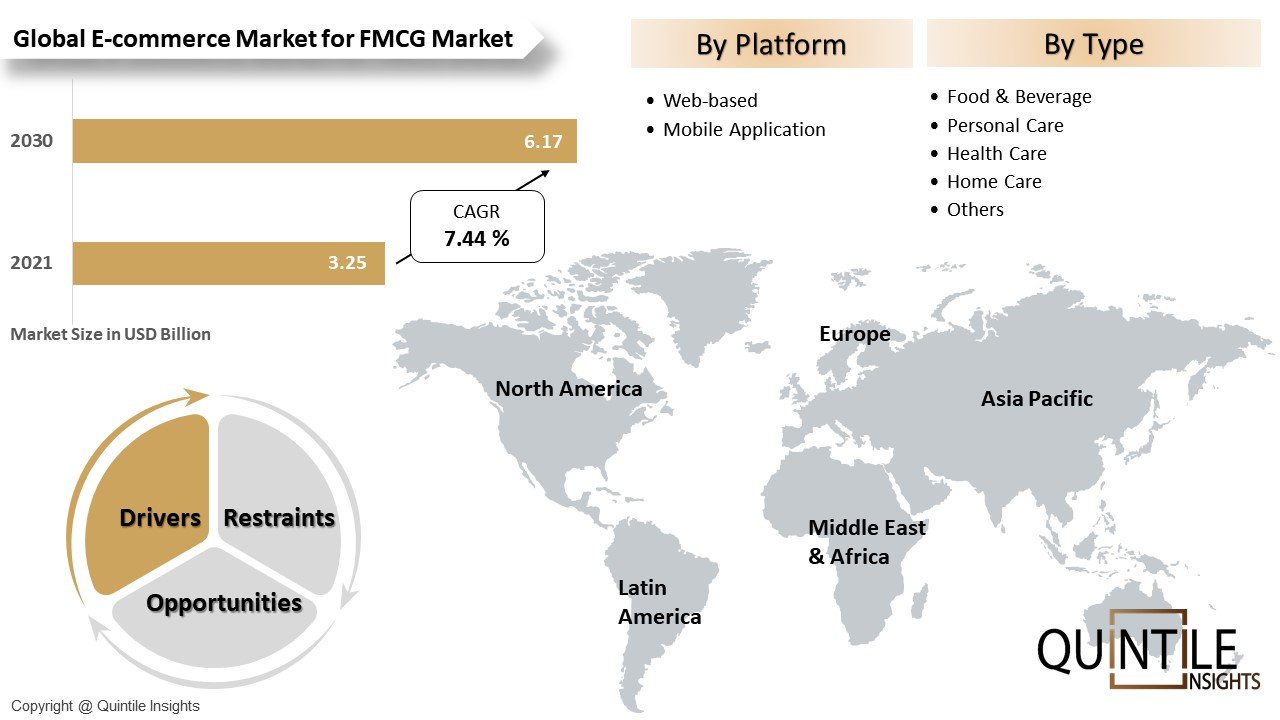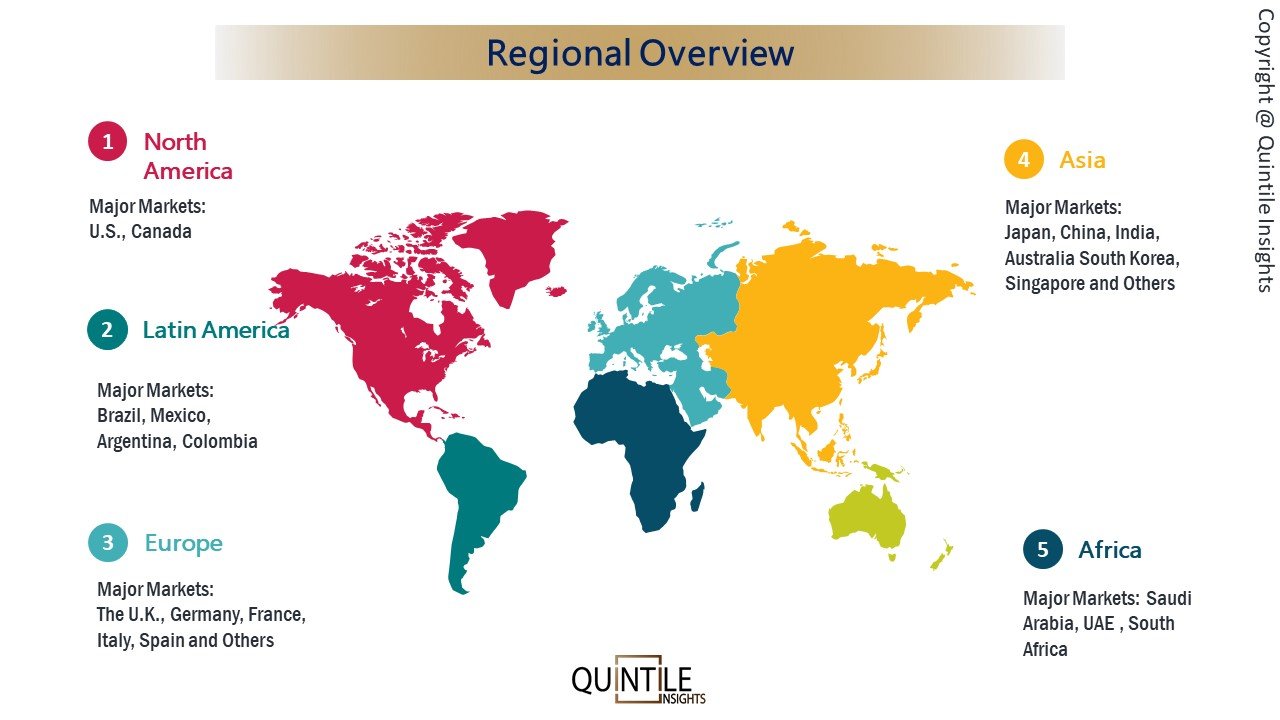Market Summary
The global e-commerce market forFMCG market was valued at USD 3.25 trillion in 2021 and it is predicted to rise
at a compound annual growth rate (CAGR) of 7.46 % from 2022 to 2030. With the
introduction of SaaS-based e-commerce software, the subscription models of
businesses have seen a boom which has resulted in the adoption of e-commerce
and its usage in small and medium enterprises. Enterprise owners are offering
online delivery as well as pick-up options, making the setting an omni-channel
platform. Leading retailers using this type of platform are Flipkart, Amazon,
and Walmart.
The fast-moving consumer goods
industry deals with products that are cheaper to produce and buy and are
essential for the end-users. The recent years have witnessed an upward trend in
e-commerce platforms integrating with the FMCG sector. It is mostly facilitated
by consumer behaviour change, internet penetration, fast urbanization, and
increased disposable income.
“Subscription-based Models and
Availability of Multiple Vendors Globally Fuels the Market”
The shopping patterns of consumers
are changing by the day. Due to the ease of access to a plethora of products,
digitization of the market and availability of the internet, the end-users are
observing a paradigm shift from traditional retail stores and shops-based
purchasing of FMCG products to e-commerce-based methods which provide the
customers subscription-based models and multiple product options. This market thrives
on a huge amount of data generated by the use of devices connected by IoT,
which can be gathered, analyzed and interpreted to maximize the consumer
engagement towards such platforms. Big data is also beneficial to create
effective and tailored marketing strategies targeted toward customer
specificity. The COVID-19 disruption has slowed down the pace of the market due
to supply chain commotions, but adaptability has increased due to lockdowns and
online penetration.

To learn more about this report, request a free sample copy
SEGMENT OUTLOOK:
The global E-commerce market for
FMCG market is segmented based on type and platform.
By Type:
Based on type, the e-commerce
market for FMCG market is segmented into food & beverage, personal care,
health care, home care and others. The food & beverage type of FMCG
products have dominated the market when it comes to sales through e-commerce
channels. The growth of the food & beverage market is impressive, however,
it is far slower than the 99.0% surge the category saw in 2020, when
wary consumers pivoted to buying online at the onset of the pandemic. However,
quick processing and delivery are critical and have traditionally been a
challenge for retailers trying to take advantage of the immense ecommerce
opportunity.
The right e-commerce strategy,
technology, and logistics solutions for food and beverage retailers of all
types and sizes hold the ability to gain a higher market share and even
dominate this sector. Some of the examples of e-commerce channels for food
& beverage include, click and collect by Walmart+ which lets the consumer
to purchase the goods through the online forum and go to the physical stores
for a pick-up; retail grocery delivery by Amazon which enables the customers to
buy groceries from whole foods through Amazon.com with subscribe & save for
scheduled auto-deliveries, also Amazon Fresh for same-day delivery and Prime
Now from local whole foods locations only, and free for Prime subscribers.
The rest of the types, mainly
personal and health care have seen consumer interest skyrocketed at the height
of the pandemic in 2020. Global user penetration in the health and personal
care market (including hair care, shower & bath, oral care, deodorants, and
shaving) is expected to surge to 32.8% by 2024, according to a McKinsey survey.
Ecommerce personal care saw record growth last year due to the pandemic, seeing
6% growth as part of all ecommerce sales. That may not seem like much, but
that’s almost 3x the growth seen the year before. The year before that, this
category saw just 3.5% growth.
By Platform:
Based on the platform, the
e-commerce market for the FMCG market is segmented into web-based and mobile
applications. The digital touchpoints for the consumer play a vital role in the
e-commerce market for the FMCG sector. The end-users want a similar experience
as the physical stores brought about on the websites and mobile applications.
Also, these particular types enable the provision of tailored experiences to
the customers which is a very strong driver in the market.
Future businesses have seen a rapid
adaptation of these websites and mobile apps by retailers and enterprises. The
COVID-19 pandemic has further accelerated this shift. Businesses use tools and
technologies such as CRM and IoT-enabled devices to gather data on customer
interaction with the brand across multiple touchpoints. This allows them to
offer customized experiences using AI, augmented reality/virtual reality, etc.,
in the physical and digital environments.
As working from home has become the
new normal, businesses are using digital interventions, such as remote
selling/video calling to connect with consumers by setting up websites and
mobile applications. This will also help re-evaluate priority customers and
cater to the shift in focus from urban to rural on account of rapid reverse
migration. Remote selling consists of an end-to-end sales cycle starting from
creating awareness to providing after-sales service. Given the pandemic, brands
are expected to continue to explore this option to provide a better customer
experience and supplement sales.
By Regional Outlook:
Based on geography, the e-commerce
market for FMCG market is segmented into North America, Europe, Asia Pacific,
Latin America, and Middle East & Africa.

To learn more about this
report, request a free sample copy
In 2020, The North America
e-commerce retail market is anticipated to grow at a substantial CAGR during
the forecast period. The triangular continent, North America, gives strength to
the global economy besides having only 5% of the global population. The
e-commerce retail market is one of them which is enjoying huge growth in the
North American region. According to an estimate by the US Census Bureau, the
total sales of e-commerce retail in North America increased by 7.8% in the
first quarter of 2021 as compared with the first quarter of 2020 and reached
USD 1,581.4 billion. The discounted rates of products are attracting customers
to choose them over in-store purchases. Amazon occupies the major market share,
although its share has been reduced recently due to increased direct brand
sales. Fashion product sales contribute more to the market which includes
apparel and footwear.
In 2021, FMCG statistics for Europe
look better when looking at the share of FMCG in total e-commerce. This equates
to sales of USD 5.4 billion, making FMCG the fastest-growing category in
German e-commerce. In other European countries, too, fast-moving products are
one of the fastest-growing categories in online retailing. This can be
explained by the fact that the other categories previously grew rapidly and
FMCG has some catching up to do here. One reason for the still relatively weak
demand for FMCG online in Europe is the deep-seated habit of consumers, who buy
everyday items spontaneously without much planning. A limitation of purchasing
such products online is the lack of the possibility to check the freshness of
the products before purchasing.
Asia Pacific FMCG bounced back with
4.3% growth vs a relatively flat 2020. Through our retail measurement tracking,
we see that 9 out of 14 markets are showing growth compared to 2019
(pre-covid), including the Chinese mainland, India, Singapore, South Korea,
Indonesia, Taiwan, Australia, and New Zealand. Markets such as Myanmar, Hong
Kong, Thailand, and Vietnam are still declining due to varying internal and
external factors though are showing signs of recovery in Q4 2021.
By Key Competitors and Market Share Analysis:
As a result, leading firms are focused on maintaining long-term operations and developing manufacturing and distribution capabilities to increase their market position. The competition among the players is based on numerous parameters including quality, innovation, product offerings, price, and corporate reputation.
Recent Developments:
- Shopify to Acquire Deliverr
for $2.1B: Building the Future of Global Logistics for Independent
BrandsIn February 2020, Permobil signed an agreement to acquire Supported
B.V. to fasten its production process and strengthen its seating and
positioning footprint in the EMEA region.
- Shopify Merchants Support
Largest Workforce in the World, Contributing 5M Jobs and $444B+ in
Economic Activity in 2021
The following are some of the major
market players operating across the globe:
- Shopify, Inc.
- SAP SE
- Oracle Corporation
- Magento Commerce (Adobe)
- Salesforce.com, Inc.
- Apttus
- Intershop Communications AG
- BigCommerce
- WooCommerce
- Sitecore
- Episerver
- Kentico Software
- Unilog Content Solutions Pvt.
Ltd.
Report Covering | Details |
Market size value in 2021 | USD 3.25 trillion |
Revenue forecast in 2030 | USD 6.17 trillion |
Growth rate | CAGR of 7.46 % from 2022 to 2030 |
Base year for estimation | 2021 |
Historical data | 2017 - 2020 |
Forecast period | 2022 - 2030 |
Quantitative units | Revenue in USD million/billion and CAGR from 2022 to 2030 |
Report coverage | Market dynamics such as Drivers, Restraints, Market Trends and Opportunities, Revenue size, market share, company ranking, competitive landscape, geographical presence, recent developments, strategic initiatives, and overall contribution to the market. |
Segments covered | |
Regional scope | North America; Europe; Asia Pacific; and Middle East & Africa |
Country Scope | U.S.; Canada; Germany; France; U.K.; Italy; Spain; China; Japan; India; South Korea; Mexico; Brazil; Argentina; Colombia; Saudi Arabia; UAE; South Africa |
Key companies profiled | Shopify, Inc., SAP SE, Oracle Corporation, Magento Commerce (Adobe), Salesforce.com, Inc., Apttus Intershop Communications AG, BigCommerce, WooCommerce, Sitecore, Episerver, Kentico Software, Unilog Content Solutions Pvt. Ltd. |
We also provide customized reports and If the information you seek is not included in the current scope of the study, kindly share your specific requirements (any category, subcategory, company profile, region, etc.), we can have a feasibility check and we could incorporate the same as a part of report customization at no additional cost. | |
Avail of customized purchase options to meet your exact research needs. Explore purchase options click to buy or write us at xxx@gmail.com |
To learn more about this
report, request a free sample copy

